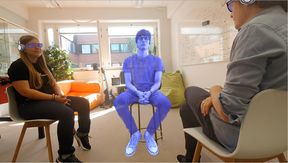Public defence in Acoustics and Audio Signal Processing, M.Sc. Nils Meyer-Kahlen
Public defence from the Aalto University School of Electrical Engineering, Department of Information and Communications Engineering

When
Where
Event language(s)
The title of the thesis: Transfer-Plausible Acoustics for Augmented Reality
Thesis defender: Nils Meyer-Kahlen
Opponent: Prof. Christoph Pörschmann, Technische Hochschule Köln, Germany
Custos: Prof. Tapio Lokki, Aalto University School of Electrical Engineering, Department of Information and Communications Engineering
Augmented Reality (AR) telepresence could be a promising future communication technology. It refers to the idea of using AR glasses and acoustically transparent headphones to augment the real world with visual and auditory renderings of remote conversation partners, similar to the blue holograms known from the science-fiction universe.
This work focuses on the audio technology required for such AR calls, which has reached an interesting point in its development. Whereas photorealistic virtual avatars that could be confused with real humans cannot be expected anytime soon, acoustic rendering of virtual sound sources over headphones can already cause auditory illusions, i.e., listeners confuse them with real sound sources under some conditions.
Perfect auditory AR rendering requires transparent headphones, full positional tracking of the user, real-time identification of the acoustic environment, and efficient room acoustic rendering algorithms. The presented work aims to understand these technologies and, most importantly, strives to establish an evaluation paradigm for testing whether auditory illusions occur under realistic conditions, termed "transfer-plausibility."
Regarding technical developments, the thesis provides a deeper understanding of spatial audio rendering techniques. For example, it derives the statistical distribution of the instantaneous pseudo-intensity vector in room acoustic late reverberation. This general result could be applied to other domains where anisotropic, stochastic fields occur. Also, the thesis explains how roughness artifacts can arise when rendering spatial reverberation.
In addition, it provides technologies that can be applied in practice, i.e., an algorithm for blind room acoustic identification and a method of assessing the transparency of headphones used for AR. Finally, the proposed “transfer-plausibility” paradigm revealed differences between auditory rendering conditions that could not be measured using more traditional listening experiments. This indicates that it is suitable for future AR audio experiments.
Keywords: Virtual Acoustics, Augmented Reality, Spatial Room Impulse Response Processing, Room Acoustics, Plausibility
Thesis available for public display 10 days prior to the defence at: https://aaltodoc.aalto.fi/doc_public/eonly/riiputus/
Contact:
| [email protected] | |
| Mobile | +358449590521 |
Doctoral theses in the School of Electrical Engineering: https://aaltodoc.aalto.fi/handle/123456789/53